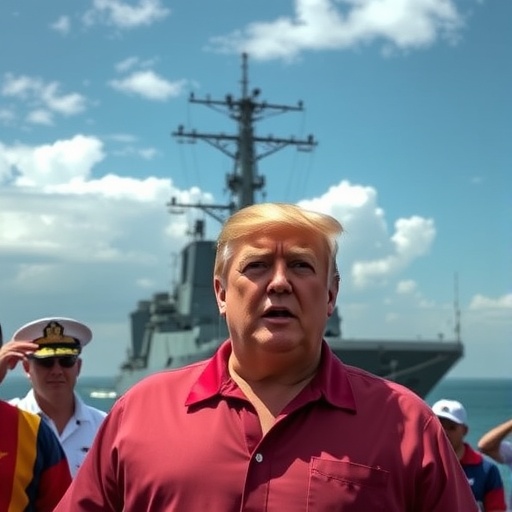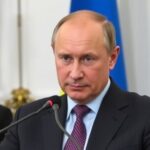Maduro Accuses Trump of Staging War as USS Gerald R. Ford Looms Near Venezuelan Coast
In a blistering speech broadcast nationwide, Venezuelan President Nicolás Maduro has accused the Trump administration of fabricating a pretext for war, pointing to the ominous approach of the USS Gerald R. Ford aircraft carrier toward Venezuelan waters as irrefutable evidence of U.S. aggression. The carrier, the largest and most advanced in the U.S. Navy’s fleet, is reportedly conducting exercises just 200 miles off the coast, heightening fears of an imminent confrontation in the oil-rich nation already reeling from economic turmoil.
Maduro’s remarks, delivered during a rally in Caracas attended by thousands of supporters waving red banners, come amid a series of provocative U.S. military maneuvers in the Caribbean. “The empire of the north, led by Trump, is inventing ghosts of conflict to justify their invasion,” Maduro thundered, his voice echoing through the humid air. “This aircraft carrier is not a ship of peace; it’s a floating fortress of imperialism aimed at our sovereign soil.” The accusation has sent shockwaves through Latin America, reigniting debates over U.S. interventionism in the region.
Maduro’s Rally Cry: Exposing U.S. ‘Warmongering’ Tactics
President Maduro, who has led Venezuela since 2013 following the death of Hugo Chávez, framed the U.S. actions as part of a long-standing plot to topple his socialist government. Speaking from the balcony of the Miraflores Palace, he detailed what he called a “manufactured crisis,” citing intelligence reports of U.S. spy planes overflying Venezuelan airspace and increased naval patrols in the Strait of Florida. “Trump’s war machine is revving up, but we will not bow,” Maduro declared, invoking the legacy of Simón Bolívar, the liberator of South America.
The Venezuelan leader’s rhetoric isn’t new; he’s frequently clashed with Washington over his handling of the country’s hyperinflation and humanitarian crisis. According to official Venezuelan data, inflation hit 1.7 million percent in 2018, driving millions to flee as borders. Yet Maduro blames U.S. sanctions—imposed by the Trump administration in 2017—for exacerbating the woes. “These sanctions are economic warfare,” he said, quoting a United Nations report that estimates over 40,000 Venezuelan deaths linked to medicine shortages caused by the blockade.
Supporters at the rally, many clad in Bolivarian militia uniforms, chanted “Yankee go home!” as Maduro outlined defensive measures. Venezuela‘s military, numbering around 120,000 active personnel, has been placed on high alert, with Russian-supplied S-300 missile systems reportedly activated along the coastline. Analysts note that Maduro’s accusations serve a dual purpose: rallying domestic support amid protests and seeking solidarity from allies like Russia and China, who have provided billions in loans to prop up the regime.
USS Gerald R. Ford’s Deployment: A Show of Force in Tense Waters
The USS Gerald R. Ford, commissioned in 2017 at a cost of $13 billion, represents the pinnacle of American naval power. Displacing 100,000 tons and capable of carrying 75 aircraft, including F-35 stealth fighters, the carrier is on its maiden operational deployment in the U.S. Southern Command area. Pentagon officials insist the exercises are routine, aimed at countering narcotics trafficking and ensuring freedom of navigation in international waters. “This is not about Venezuela specifically,” a U.S. defense spokesperson told reporters in Miami. “Our presence deters threats from multiple actors in the region.”
However, the timing couldn’t be more provocative. The carrier strike group, including destroyers and submarines, arrived off Venezuela’s coast just days after Trump tweeted about “monitoring the situation closely” in response to reports of Venezuelan forces clashing with opposition groups near the Colombian border. Satellite imagery from commercial providers like Planet Labs shows the Ford conducting flight operations, with jets launching at dawn— a sight that Venezuelan state media has dubbed “the shadow of invasion.”
Historical precedents abound. During the Cold War, U.S. carriers patrolled the Caribbean during the 1962 Cuban Missile Crisis, nearly sparking nuclear war. More recently, in 2019, Trump authorized the deployment of the USS Abraham Lincoln to the region amid threats against Iran, but pivoted attention to Venezuela when Maduro’s regime cracked down on protests. Military experts, such as retired Admiral James Stavridis, warn that the aircraft carrier’s proximity could escalate misunderstandings into firefights. “Accidental engagements in crowded seas are a real risk,” Stavridis said in an interview with CNN. “Diplomatic channels must remain open.”
Trump Administration’s Venezuela Strategy: Sanctions to Showdowns
Under President Trump, U.S. policy toward Venezuela has hardened into a campaign of maximum pressure. Since recognizing opposition leader Juan Guaidó as interim president in 2019, the administration has slapped sanctions on PDVSA, Venezuela’s state oil company, freezing $7 billion in assets and banning imports. Trump himself has mused about military options, once telling reporters, “All options are on the table,” in reference to regime change.
The aircraft carrier’s approach fits into this broader strategy. U.S. officials, speaking anonymously to The New York Times, revealed that the deployment was greenlit after intelligence suggested Maduro was accelerating uranium enrichment—claims Venezuela denies, calling them “Trump’s fairy tales.” The White House has tied the military posturing to humanitarian concerns, pointing to the exodus of 5.4 million Venezuelans since 2015, per UNHCR figures. Aid convoys blocked by Maduro’s forces in 2019 led to border skirmishes, further straining ties.
Trump’s inner circle, including National Security Advisor John Bolton (before his 2019 ousting), advocated for a “Libya model” of intervention to remove Maduro. While no invasion has materialized, the U.S. has bolstered allies like Colombia with $200 million in military aid to secure borders. Critics, including Amnesty International, argue that such tactics risk provoking a humanitarian catastrophe. “Escalating military presence only deepens the suffering,” said Amnesty’s Erika Guevara-Rosas.
In Congress, bipartisan support for tough measures persists. A 2020 bill allocated $50 million for democracy programs in Venezuela, but hawks like Senator Marco Rubio push for more. Rubio tweeted recently: “Maduro’s lies won’t hide his crimes. America’s resolve is unbreakable.” This rhetoric underscores how Venezuela has become a flashpoint in U.S. domestic politics, with Trump using it to appeal to his Latin American voter base.
Global Echoes: Allies and Adversaries React to the Standoff
The international community is watching the Venezuela-Trump war of words with alarm. Russia, Venezuela’s key benefactor, dispatched two nuclear-capable bombers to Caracas in 2019, prompting U.S. condemnation. Kremlin spokesman Dmitry Peskov stated, “Any aggression against Venezuela would face consequences,” alluding to potential cyberattacks or arms shipments. China, holding $60 billion in Venezuelan debt, urged restraint via state media, emphasizing “peaceful dialogue.”
In Latin America, reactions are mixed. Brazil’s President Jair Bolsonaro, a Trump ally, has hosted U.S. troops for joint exercises, while Mexico and Argentina call for mediation through the Organization of American States (OAS). OAS Secretary-General Luis Almagro accused Maduro of “dictatorial maneuvers,” citing election fraud in 2018 that the U.S. deemed illegitimate.
European nations, led by the EU, have imposed their own sanctions on Maduro’s inner circle, freezing assets of 25 officials. France’s President Emmanuel Macron warned in a G7 statement that “military adventurism serves no one.” Meanwhile, Iran has offered Venezuela oil in exchange for gold, circumventing U.S. blockades—a move Trump labeled “desperate alliances of dictators.”
Non-governmental organizations paint a grim picture. Human Rights Watch reports over 250 arbitrary detentions of opposition figures since 2020, fueling Maduro’s narrative of U.S.-backed coups. The International Monetary Fund estimates Venezuela’s GDP has shrunk 75% since 2013, making it the world’s worst economic contraction outside wartime.
Path Forward: Diplomatic Thaw or Escalating Conflict?
As the USS Gerald R. Ford lingers in the region, the stakes for U.S.-Venezuela relations could not be higher. Diplomatic efforts, including backchannel talks in Norway in 2019, have stalled, but whispers of new negotiations persist. The Biden transition team has signaled a review of Trump-era policies, potentially easing sanctions if Maduro agrees to free elections— a demand echoed by the UN Security Council.
For Venezuelans, the human cost looms large. With 96% of the population in poverty per ENCOVI surveys, any war would devastate the already fragile infrastructure. Maduro vows to resist, mobilizing the civilian-armed colectivos, while Trump-era holdovers in the State Department prepare contingency plans for refugee surges.
Experts predict a delicate balance: the aircraft carrier may withdraw after exercises conclude in two weeks, averting immediate crisis. Yet unresolved issues—oil disputes, migration, and democracy—ensure tensions simmer. As one Caracas analyst put it, “This isn’t the end; it’s the prelude to whatever comes next in the Americas.” International observers urge de-escalation, with the UN’s António Guterres calling for “dialogue over division.” The world waits to see if words will yield to weapons or wisdom prevails.










